Ortiz de Montellano Paul R.(Ed.) Cytochrome P450. Structure, Mechanism, and Biochemistry
Подождите немного. Документ загружается.

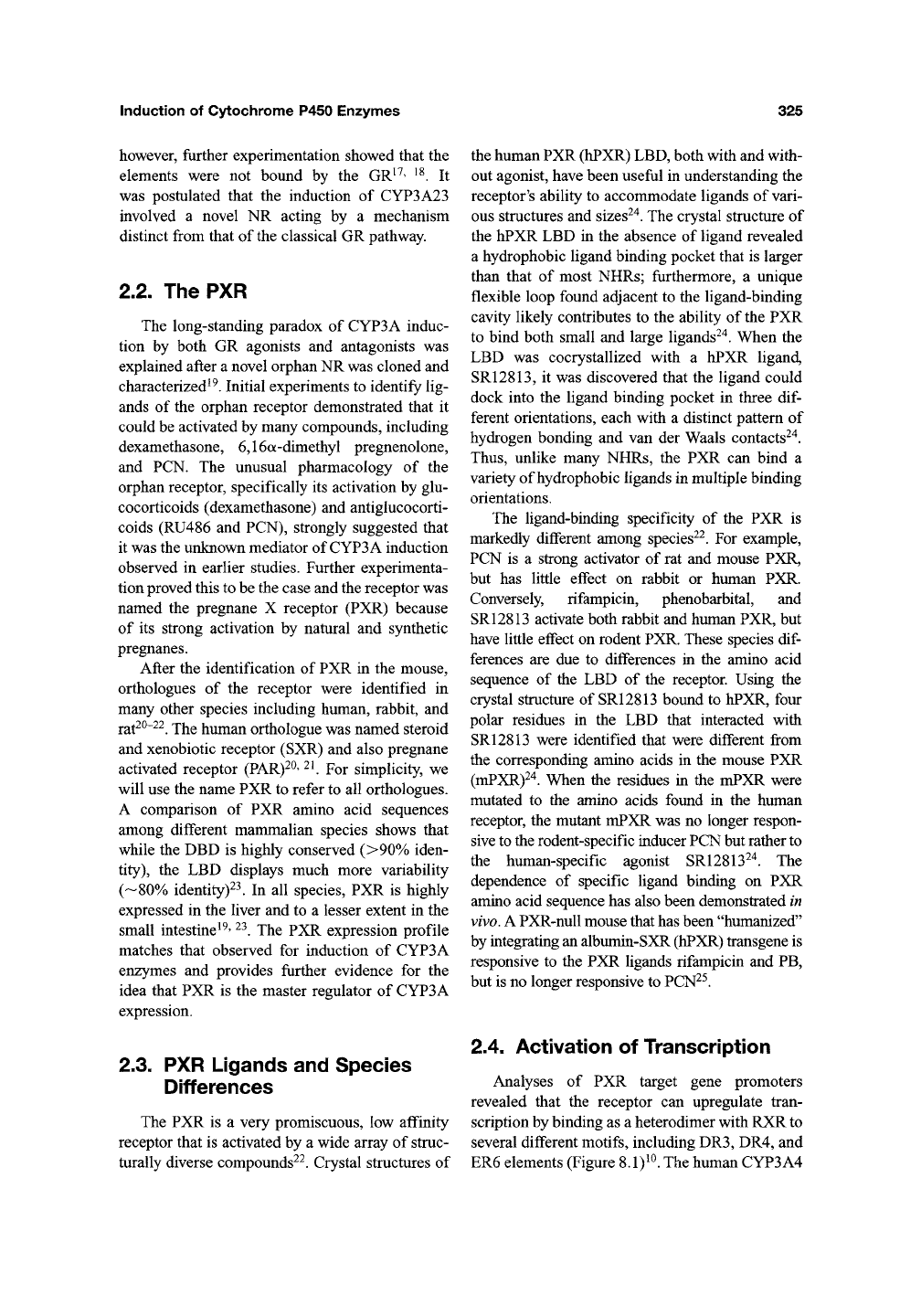
Induction
of
Cytochrome P450 Enzymes
325
however, further experimentation showed that
the
elements were
not
bound
by the GR^^' ^^. It
was postulated that
the
induction
of
CYP3A23
involved
a
novel
NR
acting
by a
mechanism
distinct from that
of
the
classical GR pathway
2.2.
The PXR
The long-standing paradox
of
CYP3A induc-
tion
by
both
GR
agonists
and
antagonists
was
explained after
a
novel orphan NR was cloned and
characterized^^. Initial experiments
to
identify lig-
ands
of
the orphan receptor demonstrated that
it
could be activated by many compounds, including
dexamethasone, 6,16a-dimethyl pregnenolone,
and
PCN. The
unusual pharmacology
of the
orphan receptor, specifically
its
activation
by
glu-
cocorticoids (dexamethasone)
and
antiglucocorti-
coids (RU486
and
PCN), strongly suggested that
it was the unknown mediator of CYP3A induction
observed
in
earlier studies. Further experimenta-
tion proved this to be the case and the receptor was
named
the
pregnane
X
receptor
(PXR)
because
of
its
strong activation
by
natural
and
synthetic
pregnanes.
After
the
identification
of
PXR
in the
mouse,
orthologues
of the
receptor were identified
in
many other species including human, rabbit,
and
j.^^20-22
jY^Q
human orthologue was named steroid
and xenobiotic receptor (SXR)
and
also pregnane
activated receptor (PAR)^^'
^^ For
simplicity,
we
will use the name PXR
to
refer to
all
orthologues.
A comparison
of PXR
amino acid sequences
among different mammalian species shows that
while
the
DBD
is
highly conserved (>90% iden-
tity),
the LBD
displays much more variability
(-80% identity)23.
In all
species,
PXR is
highly
expressed
in
the liver
and to a
lesser extent
in the
small intestine^^' ^^.
The PXR
expression profile
matches that observed
for
induction
of
CYP3A
enzymes
and
provides further evidence
for the
idea that
PXR is the
master regulator
of
CYP3A
expression.
2.3.
PXR
Ligands
and
Species
Differences
The
PXR is a
very promiscuous,
low
affinity
receptor that
is
activated
by a
wide array
of
struc-
turally diverse compounds^^. Crystal structures
of
the human PXR (hPXR) LBD, both with and with-
out agonist, have been useful
in
understanding
the
receptor's ability
to
accommodate ligands
of
vari-
ous structures
and
sizes^"^.
The crystal structure
of
the hPXR LBD
in the
absence
of
ligand revealed
a hydrophobic ligand binding pocket that
is
larger
than that
of
most NHRs; furthermore,
a
unique
flexible loop found adjacent
to the
ligand-binding
cavity likely contributes
to the
ability
of
the
PXR
to bind both small
and
large ligands^"^. When
the
LBD
was
cocrystallized with
a
hPXR ligand,
SRI2813,
it
was discovered that
the
ligand could
dock into
the
ligand binding pocket
in
three
dif-
ferent orientations, each with
a
distinct pattern
of
hydrogen bonding
and van der
Waals contacts^"^.
Thus,
unlike many NHRs,
the PXR can
bind
a
variety of hydrophobic ligands in multiple binding
orientations.
The ligand-binding specificity
of the PXR is
markedly different among species^^.
For
example,
PCN
is a
strong activator
of rat and
mouse
PXR,
but
has
little effect
on
rabbit
or
human
PXR.
Conversely, rifampicin, phenobarbital,
and
SR12813 activate both rabbit and human PXR,
but
have little effect
on
rodent PXR. These species
dif-
ferences
are due to
differences
in the
amino acid
sequence
of the LBD of the
receptor. Using
the
crystal structure
of
SR12813 bound
to
hPXR, four
polar residues
in the LBD
that interacted with
SRI 2813 were identified that were different from
the corresponding amino acids
in the
mouse
PXR
(mPXR)^"^. When
the
residues
in the
mPXR were
mutated
to the
amino acids found
in the
human
receptor,
the
mutant mPXR was
no
longer respon-
sive to the rodent-specific inducer PCN but rather to
the human-specific agonist SR12813^'^.
The
dependence
of
specific ligand binding
on PXR
amino acid sequence has also been demonstrated
in
vivo.
A
PXR-null mouse that has been "humanized"
by integrating an albumin-SXR (hPXR) transgene
is
responsive
to the PXR
ligands rifampicin
and PB,
but
is
no longer responsive
to
PCN^^.
2.4. Activation
of
Transcription
Analyses
of PXR
target gene promoters
revealed that
the
receptor
can
upregulate tran-
scription by binding as a heterodimer with RXR to
several different motifs, including DR3, DR4,
and
ER6 elements (Figure 8.1)^^. The human CYP3A4
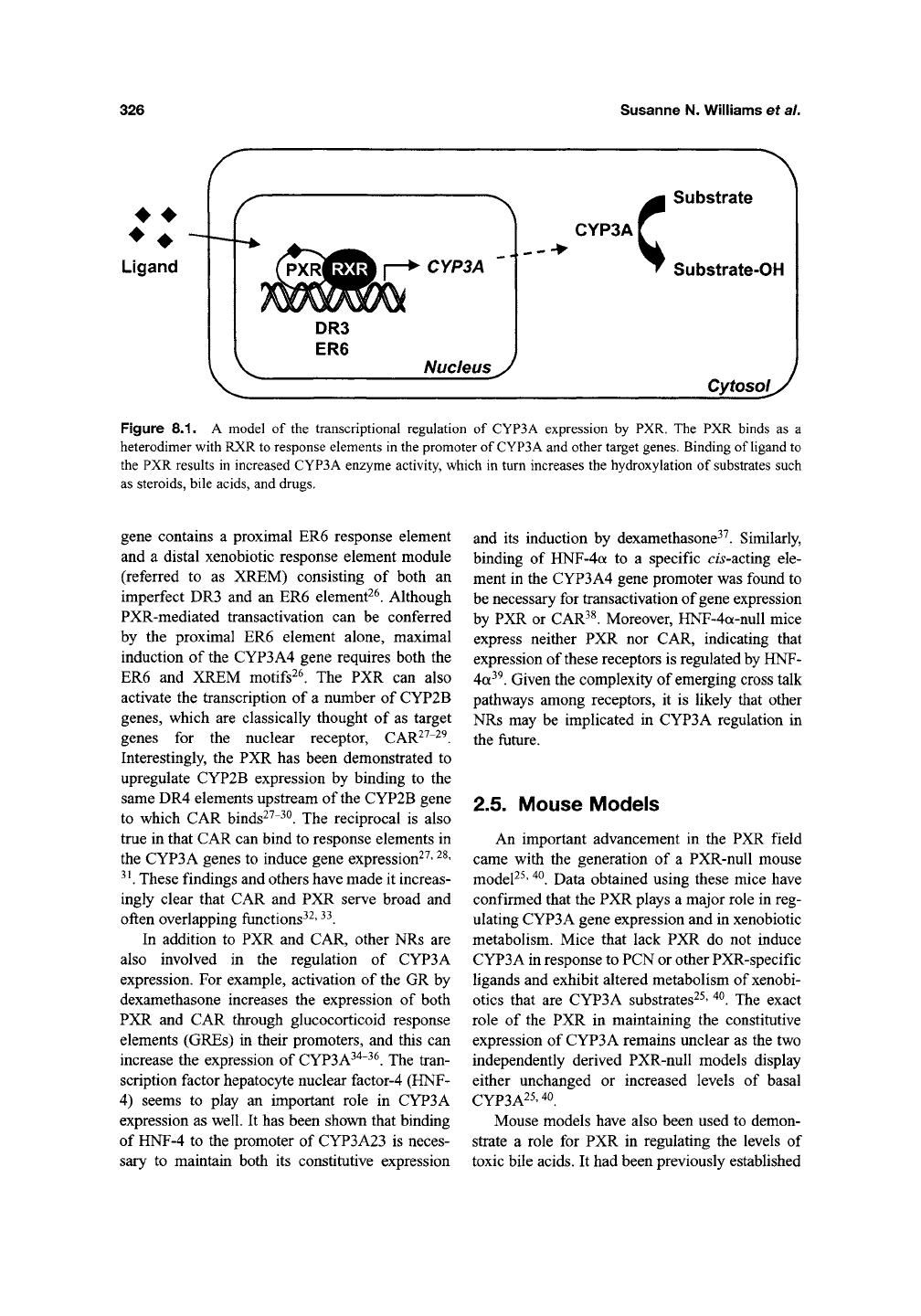
326 Susanne
N.
Williams
et al.
CYP3A
c
Substrate
Substrate-OH
Cytosol,
Figure
8.1. A
model
of the
transcriptional regulation
of
CYP3A expression
by PXR. The PXR
binds
as a
heterodimer with RXR to response elements
in the
promoter
of
CYP3A and other target genes. Binding
of
ligand
to
the PXR results
in
increased CYP3A enzyme activity, which
in
turn increases
the
hydroxylation
of
substrates such
as steroids, bile acids,
and
drugs.
gene contains
a
proximal
ER6
response element
and
a
distal xenobiotic response element module
(referred
to as
XREM) consisting
of
both
an
imperfect DR3
and an ER6
element^^. Although
PXR-mediated transactivation
can be
conferred
by
the
proximal
ER6
element alone, maximal
induction
of
the CYP3A4 gene requires both
the
ER6
and
XREM motifs^^.
The PXR can
also
activate
the
transcription
of a
number
of
CYP2B
genes,
which
are
classically thought
of as
target
genes
for the
nuclear receptor, CAR^^~^^.
Interestingly,
the PXR has
been demonstrated
to
upregulate CYP2B expression
by
binding
to the
same DR4 elements upstream of the CYP2B gene
to which
CAR
binds^^"^^.
The
reciprocal
is
also
true
in
that CAR can bind
to
response elements
in
the CYP3A genes
to
induce gene expression^^' ^^'
^^ These findings and others have made
it
increas-
ingly clear that
CAR and PXR
serve broad
and
often overlapping fiinctions^^' ^^.
In addition
to PXR and CAR,
other
NRs are
also involved
in the
regulation
of
CYP3A
expression.
For
example, activation
of
the
GR by
dexamethasone increases
the
expression
of
both
PXR
and CAR
through glucocorticoid response
elements (GREs)
in
their promoters,
and
this
can
increase
the
expression
of
CYP3A^^^^.
The
tran-
scription factor hepatocyte nuclear factor-4 (HNF-
4) seems
to
play
an
important role
in
CYP3A
expression
as
well.
It
has been shown that binding
of HNF-4
to the
promoter
of
CYP3A23
is
neces-
sary
to
maintain both
its
constitutive expression
and
its
induction
by
dexamethasone^^. Similarly,
binding
of
HNF-4a
to a
specific cis-acting ele-
ment
in
the CYP3A4 gene promoter was found
to
be necessary
for
transactivation of gene expression
by
PXR or
CAR^l Moreover, HNF-4a-null mice
express neither
PXR nor CAR,
indicating that
expression of these receptors
is
regulated by HNF-
4a^^. Given the complexity
of
emerging cross talk
pathways among receptors,
it is
likely that other
NRs
may be
implicated
in
CYP3A regulation
in
the ftiture.
2.5. Mouse Models
An important advancement
in the PXR
field
came with
the
generation
of a
PXR-nuU mouse
model^^'
^^.
Data obtained using these mice have
confirmed that the PXR plays
a
major role
in
reg-
ulating CYP3A gene expression and
in
xenobiotic
metabolism. Mice that lack
PXR do not
induce
CYP3A in response to PCN or other PXR-specific
ligands
and
exhibit altered metabolism
of
xenobi-
otics that
are
CYP3A substrates^^' '^^.
The
exact
role
of the PXR in
maintaining
the
constitutive
expression
of
CYP3 A remains unclear
as the two
independently derived PXR-null models display
either unchanged
or
increased levels
of
basal
CYP3A25'40^
Mouse models have also been used
to
demon-
strate
a
role
for PXR in
regulating
the
levels
of
toxic bile acids.
It
had been previously established
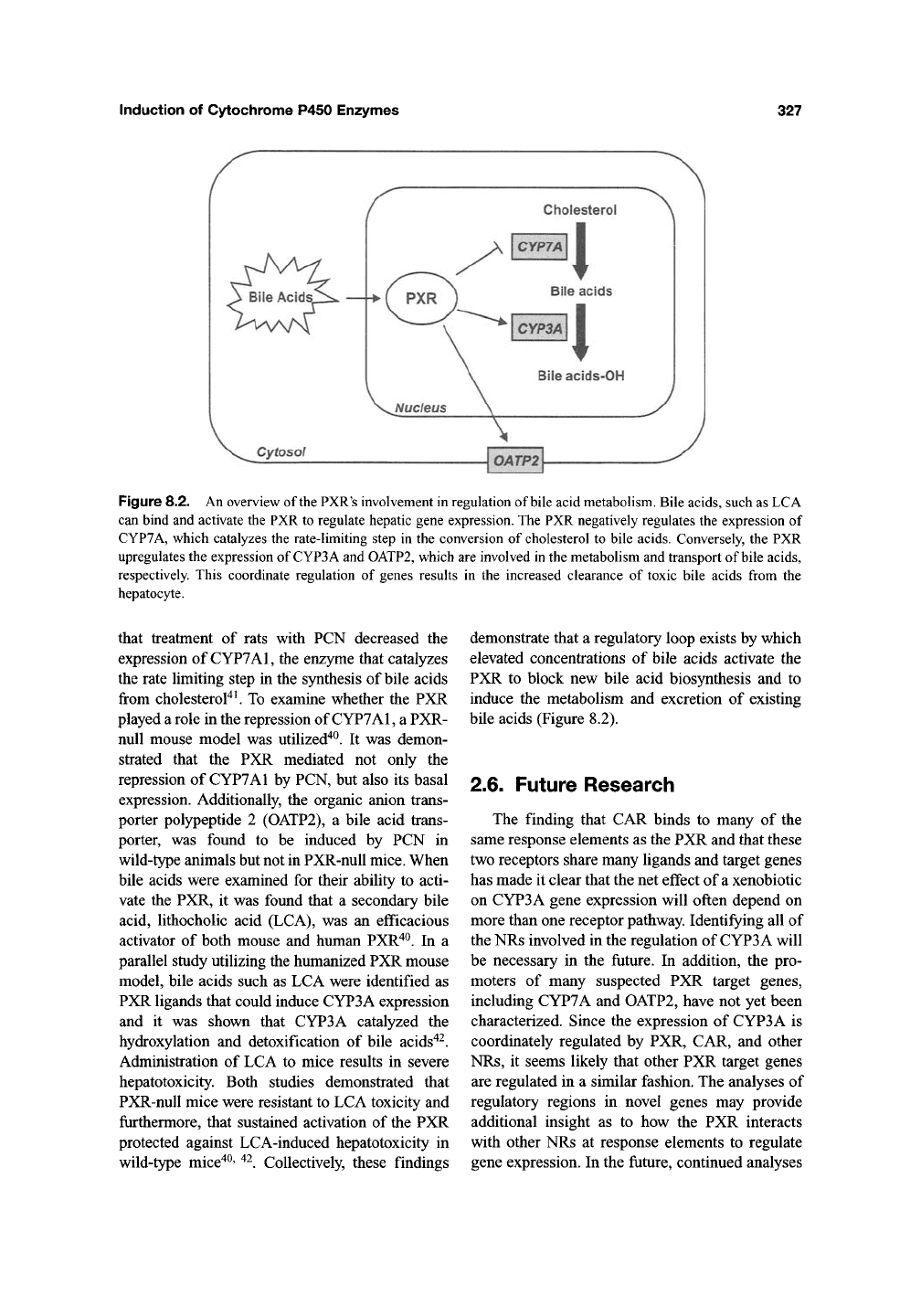
Induction of Cytochrome P450 Enzymes
327
Cholesterol
Figure 8.2. An overview of the PXR's involvement in regulation of bile acid metabolism. Bile acids, such as LCA
can bind and activate the PXR to regulate hepatic gene expression. The PXR negatively regulates the expression of
CYP7A, which catalyzes the rate-limiting step in the conversion of cholesterol to bile acids. Conversely, the PXR
upregulates the expression of CYP3A and OATP2, which are involved in the metabolism and transport of bile acids,
respectively. This coordinate regulation of genes results in the increased clearance of toxic bile acids from the
hepatocyte.
that treatment of rats with PCN decreased the
expression of
CYP7A1,
the enzyme that catalyzes
the rate limiting step in the synthesis of bile acids
from cholesterol'*^ To examine whether the PXR
played a role in the repression of
CYP7A1,
a PXR-
null mouse model was utilized"*^. It was demon-
strated that the PXR mediated not only the
repression of
CYP7A1
by PCN, but also its basal
expression. Additionally, the organic anion trans-
porter polypeptide 2 (0ATP2), a bile acid trans-
porter, was found to be induced by PCN in
wild-type animals but not in PXR-nuU mice. When
bile acids were examined for their ability to acti-
vate the PXR, it was found that a secondary bile
acid, lithocholic acid (LCA), was an efficacious
activator of both mouse and human PXR"^^. In a
parallel study utilizing the humanized PXR mouse
model, bile acids such as LCA were identified as
PXR ligands that could induce CYP3A expression
and it was shown that CYP3A catalyzed the
hydroxylation and detoxification of bile acids^^.
Administration of LCA to mice results in severe
hepatotoxicity. Both studies demonstrated that
PXR-null mice were resistant to LCA toxicity and
furthermore, that sustained activation of the PXR
protected against LCA-induced hepatotoxicity in
wild-type mice"*^' ^^. Collectively, these findings
demonstrate that a regulatory loop exists by which
elevated concentrations of bile acids activate the
PXR to block new bile acid biosynthesis and to
induce the metabolism and excretion of existing
bile acids (Figure 8.2).
2.6. Future Research
The finding that CAR binds to many of the
same response elements as the PXR and that these
two receptors share many ligands and target genes
has made it clear that the net effect of a xenobiotic
on CYP3A gene expression will often depend on
more than one receptor pathway. Identifying all of
the NRs involved in the regulation of CYP3A will
be necessary in the future. In addition, the pro-
moters of many suspected PXR target genes,
including CYP7A and 0ATP2, have not yet been
characterized. Since the expression of CYP3A is
coordinately regulated by PXR, CAR, and other
NRs,
it seems likely that other PXR target genes
are regulated in a similar fashion. The analyses of
regulatory regions in novel genes may provide
additional insight as to how the PXR interacts
with other NRs at response elements to regulate
gene expression. In the fiiture, continued analyses
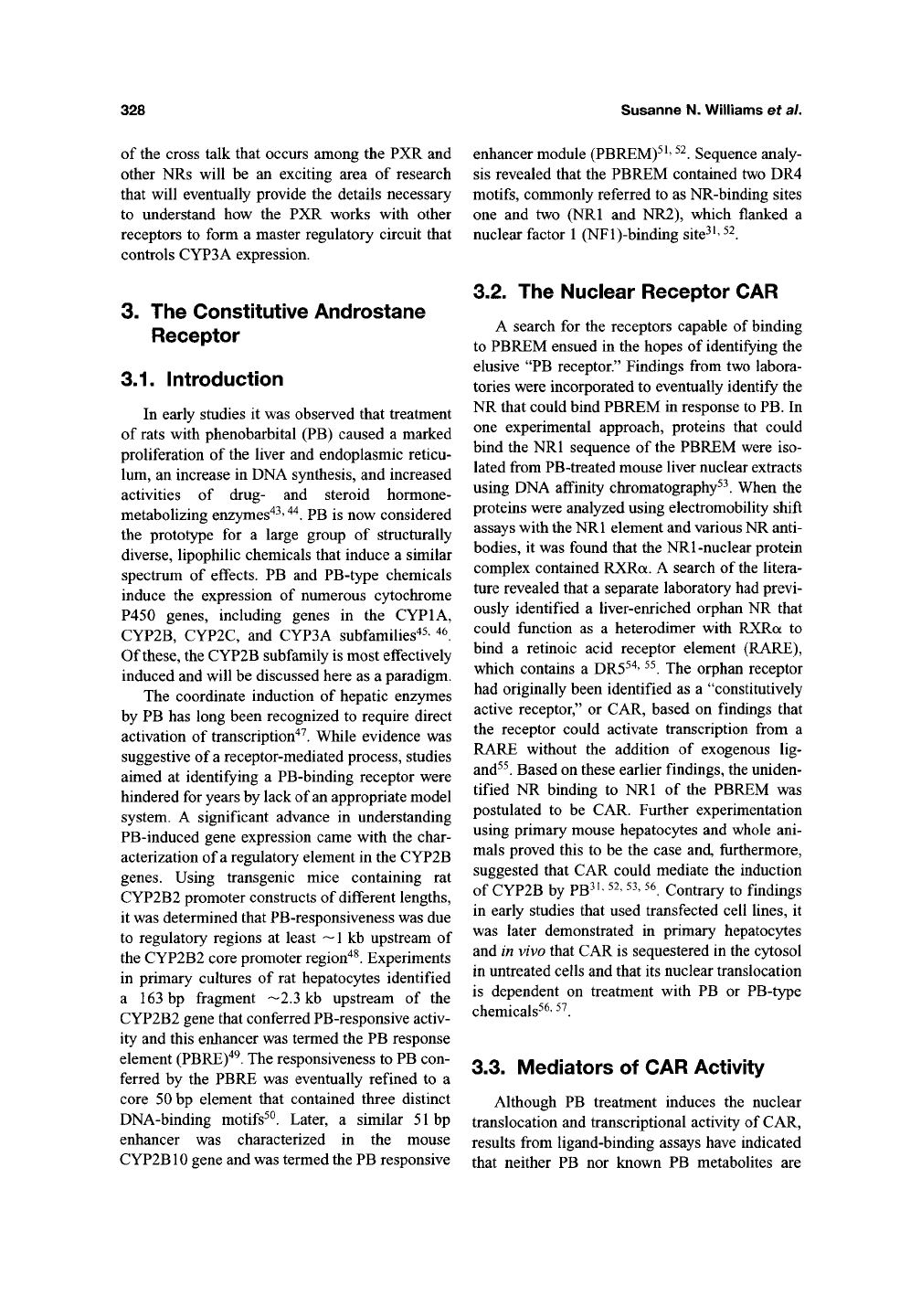
328 Susanne N. Williams et al.
of the cross talk that occurs among the PXR and
other NRs will be an exciting area of research
that will eventually provide the details necessary
to understand how the PXR works with other
receptors to form a master regulatory circuit that
controls CYP3A expression.
3. The Constitutive Androstane
Receptor
3.1.
Introduction
In early studies it was observed that treatment
of rats with phenobarbital (PB) caused a marked
proliferation of the liver and endoplasmic reticu-
lum, an increase in DNA synthesis, and increased
activities of drug- and steroid hormone-
metabolizing enzymes^^'
^^.
PB is now considered
the prototype for a large group of structurally
diverse, lipophilic chemicals that induce a similar
spectrum of effects. PB and PB-type chemicals
induce the expression of numerous cytochrome
P450 genes, including genes in the CYPIA,
CYP2B,
CYP2C, and CYP3A subfamilies^^' ^^
Of these, the CYP2B subfamily is most effectively
induced and will be discussed here as a paradigm.
The coordinate induction of hepatic enzymes
by PB has long been recognized to require direct
activation of transcription'^^. While evidence was
suggestive of
a
receptor-mediated process, studies
aimed at identifying a PB-binding receptor were
hindered for years by lack of an appropriate model
system. A significant advance in understanding
PB-induced gene expression came with the char-
acterization of a regulatory element in the CYP2B
genes.
Using transgenic mice containing rat
CYP2B2 promoter constructs of different lengths,
it was determined that PB-responsiveness was due
to regulatory regions at least ~1 kb upstream of
the CYP2B2 core promoter
region"^^.
Experiments
in primary cultures of rat hepatocytes identified
a 163 bp fragment —2.3 kb upstream of the
CYP2B2 gene that conferred PB-responsive activ-
ity and this enhancer was termed the PB response
element (PBRE)"^^. The responsiveness to PB con-
ferred by the PBRE was eventually refined to a
core 50 bp element that contained three distinct
DNA-binding motifs^^. Later, a similar 51 bp
enhancer was characterized in the mouse
CYP2B10 gene and was termed the PB responsive
enhancer module (PBREM)^^'
^^.
Sequence analy-
sis revealed that the PBREM contained two DR4
motifs, commonly referred to as NR-binding sites
one and two (NRl and NR2), which flanked a
nuclear factor
1
(NFl)-binding site^^'^^.
3.2. The Nuclear Receptor CAR
A search for the receptors capable of binding
to PBREM ensued in the hopes of identifying the
elusive "PB receptor." Findings from two labora-
tories were incorporated to eventually identify the
NR that could bind PBREM in response to PB. In
one experimental approach, proteins that could
bind the NRl sequence of the PBREM were iso-
lated from PB-treated mouse liver nuclear extracts
using DNA affinity chromatography^^. When the
proteins were analyzed using electromobility shift
assays with the NRl element and various NR anti-
bodies, it was found that the NRl-nuclear protein
complex contained RXRa. A search of the litera-
ture revealed that a separate laboratory had previ-
ously identified a liver-enriched orphan NR that
could function as a heterodimer with RXRa to
bind a retinoic acid receptor element (RARE),
which contains a DR5^'^' ^^. The orphan receptor
had originally been identified as a "constitutively
active receptor," or CAR, based on findings that
the receptor could activate transcription from a
RARE without the addition of exogenous lig-
and^^. Based on these earlier findings, the uniden-
tified NR binding to NRl of the PBREM was
postulated to be CAR. Further experimentation
using primary mouse hepatocytes and whole ani-
mals proved this to be the case and, furthermore,
suggested that CAR could mediate the induction
of CYP2B by
PB^^'
52,53,56 Contrary to findings
in early studies that used transfected cell lines, it
was later demonstrated in primary hepatocytes
and in vivo that CAR is sequestered in the cytosol
in untreated cells and that its nuclear translocation
is dependent on treatment with PB or PB-type
chemicals^^'
^^.
3.3. Mediators of CAR Activity
Although PB treatment induces the nuclear
translocation and transcriptional activity of CAR,
results from ligand-binding assays have indicated
that neither PB nor known PB metabolites are
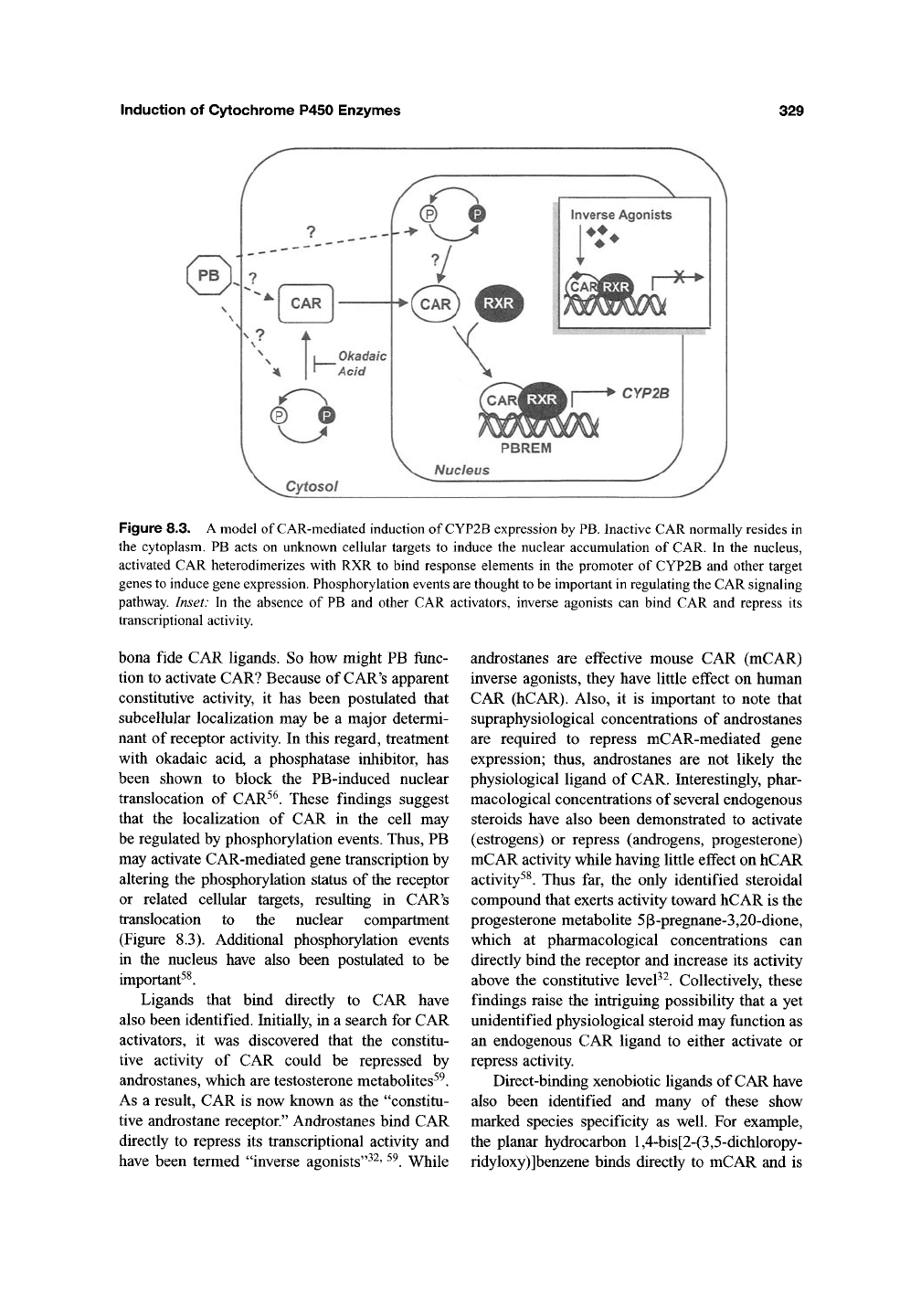
Induction of Cytochrome P450 Enzymes
329
®.
Figure 8.3. A model of CAR-mediated induction of CYP2B expression by
PB.
Inactive CAR normally resides in
the cytoplasm. PB acts on unknown cellular targets to induce the nuclear accumulation of CAR. In the nucleus,
activated CAR heterodimerizes with RXR to bind response elements in the promoter of CYP2B and other target
genes to induce gene expression. Phosphorylation events
are
thought
to
be important in regulating
the
CAR signaling
pathway. Inset: In the absence of PB and other CAR activators, inverse agonists can bind CAR and repress its
transcriptional activity.
bona fide CAR ligands. So how might PB func-
tion to activate CAR? Because of CAR's apparent
constitutive activity, it has been postulated that
subcellular localization may be a major determi-
nant of receptor activity. In this regard, treatment
with okadaic acid, a phosphatase inhibitor, has
been shown to block the PB-induced nuclear
translocation of CAR^^. These findings suggest
that the localization of CAR in the cell may
be regulated by phosphorylation events. Thus, PB
may activate CAR-mediated gene transcription by
altering the phosphorylation status of the receptor
or related cellular targets, resulting in CAR's
translocation to the nuclear compartment
(Figure 8.3). Additional phosphorylation events
in the nucleus have also been postulated to be
important^^.
Ligands that bind directly to CAR have
also been identified. Initially, in a search for CAR
activators, it was discovered that the constitu-
tive activity of CAR could be repressed by
androstanes, which are testosterone metabolites^^.
As a result, CAR is now known as the "constitu-
tive androstane receptor." Androstanes bind CAR
directly to repress its transcriptional activity and
have been termed "inverse agonists"^^' ^^. While
androstanes are effective mouse CAR (mCAR)
inverse agonists, they have little effect on human
CAR (hCAR). Also, it is important to note that
supraphysiological concentrations of androstanes
are required to repress mCAR-mediated gene
expression; thus, androstanes are not likely the
physiological ligand of CAR. Interestingly, phar-
macological concentrations of several endogenous
steroids have also been demonstrated to activate
(estrogens) or repress (androgens, progesterone)
mCAR activity while having little effect on hCAR
activity^^. Thus far, the only identified steroidal
compound that exerts activity toward hCAR is the
progesterone metabolite 5p-pregnane-3,20-dione,
which at pharmacological concentrations can
directly bind the receptor and increase its activity
above the constitutive leveP^. Collectively, these
findings raise the intriguing possibility that a yet
unidentified physiological steroid may function as
an endogenous CAR ligand to either activate or
repress activity.
Direct-binding xenobiotic ligands of CAR have
also been identified and many of these show
marked species specificity as well. For example,
the planar hydrocarbon l,4-"bis[2-(3,5-dichloropy-
ridyloxy)]benzene binds directly to mCAR and is
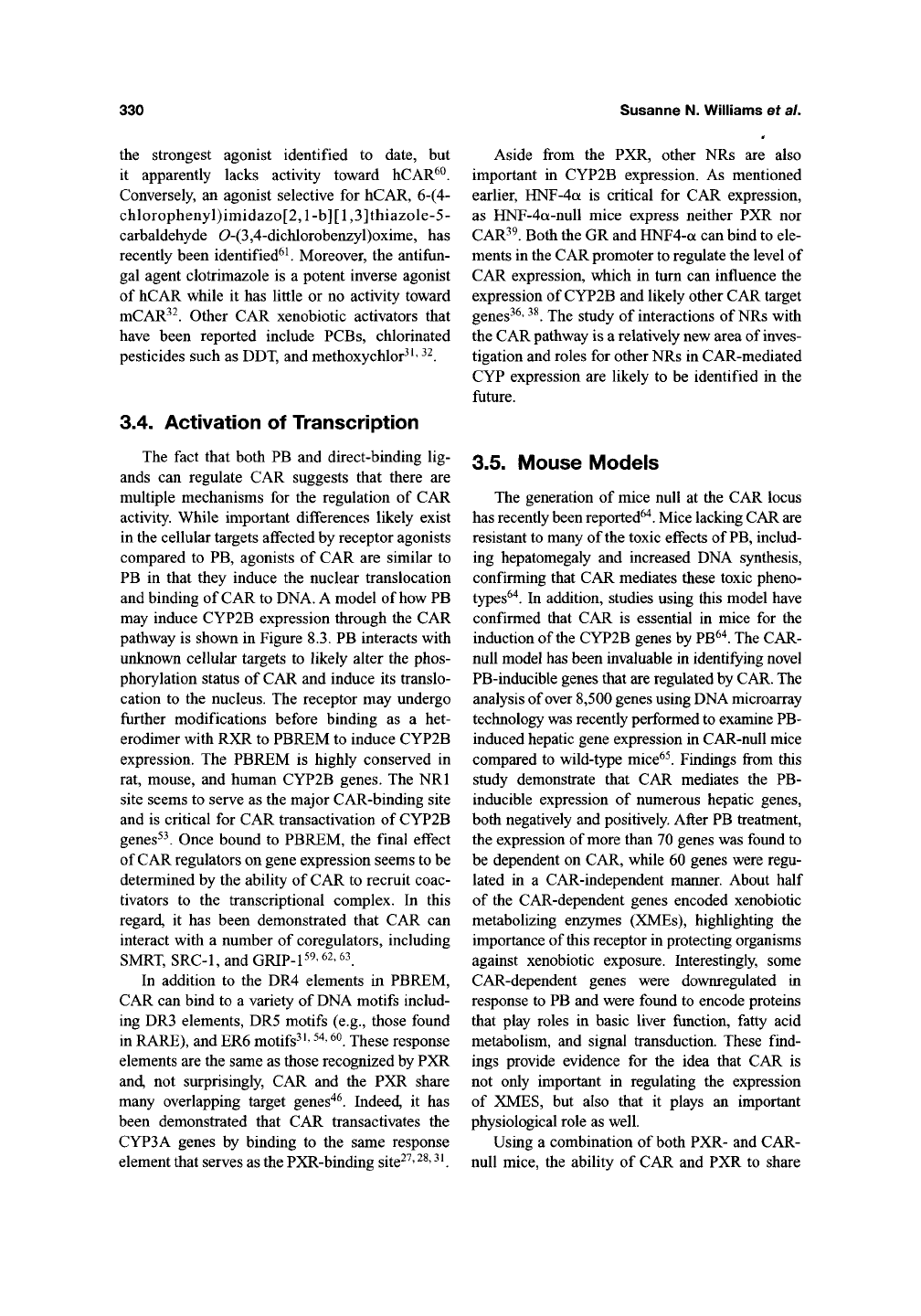
330 Susanne N. Williams et a/.
the strongest agonist identified to date, but
it apparently lacks activity toward hCAR^^.
Conversely, an agonist selective for hCAR, 6-(4-
chlorophenyl)imidazo[2,l-b][l,3]thiazole-5-
carbaldehyde 0-(3,4-dichlorobenzyl)oxime, has
recently been identified^ ^. Moreover, the antifun-
gal agent clotrimazole is a potent inverse agonist
of hCAR while it has little or no activity toward
mCAR^^. Other CAR xenobiotic activators that
have been reported include PCBs, chlorinated
pesticides such as DDT, and methoxychlor^*' ^^.
3.4. Activation of Transcription
The fact that both PB and direct-binding lig-
ands can regulate CAR suggests that there are
multiple mechanisms for the regulation of CAR
activity. While important differences likely exist
in the cellular targets affected by receptor agonists
compared to PB, agonists of CAR are similar to
PB in that they induce the nuclear translocation
and binding of CAR to DNA. A model of how PB
may induce CYP2B expression through the CAR
pathway is shown in Figure 8.3. PB interacts with
unknown cellular targets to likely alter the phos-
phorylation status of CAR and induce its translo-
cation to the nucleus. The receptor may undergo
further modifications before binding as a het-
erodimer with RXR to PBREM to induce CYP2B
expression. The PBREM is highly conserved in
rat, mouse, and human CYP2B genes. The NRl
site seems to serve as the major CAR-binding site
and is critical for CAR transactivation of CYP2B
genes^^.
Once bound to PBREM, the final effect
of CAR regulators on gene expression seems to be
determined by the ability of CAR to recruit coac-
tivators to the transcriptional complex. In this
regard, it has been demonstrated that CAR can
interact with a number of coregulators, including
SMRT,
SRC-1,
and GRIP-l^^^ 62,63
In addition to the DR4 elements in PBREM,
CAR can bind to a variety of DNA motifs includ-
ing DR3 elements, DR5 motifs (e.g., those found
in RARE), and ER6 motifs^^'
^'^' ^^.
These response
elements are the same as those recognized by PXR
and, not surprisingly, CAR and the PXR share
many overlapping target genes"^^. Indeed, it has
been demonstrated that CAR transactivates the
CYP3A genes by binding to the same response
element that serves as the PXR-binding
site^^'
^^'
^^
Aside from the PXR, other NRs are also
important in CYP2B expression. As mentioned
earlier, HNF-4a is critical for CAR expression,
as HNF-4a-null mice express neither PXR nor
CAR^^. Both the GR and HNF4-a can bind to ele-
ments in the CAR promoter to regulate the level of
CAR expression, which in turn can influence the
expression of CYP2B and likely other CAR target
genes^^'
^^.
The study of interactions of NRs with
the CAR pathway is a relatively new area of
inves-
tigation and roles for other NRs in CAR-mediated
CYP expression are likely to be identified in the
future.
3.5. IVIouse Models
The generation of mice null at the CAR locus
has recently been
reported^"^.
Mice lacking CAR are
resistant to many of the toxic effects of
PB,
includ-
ing hepatomegaly and increased DNA synthesis,
confirming that CAR mediates these toxic pheno-
types^"^.
In addition, studies using this model have
confirmed that CAR is essential in mice for the
induction of
the
CYP2B genes by PB^l The CAR-
null model has been invaluable in identifying novel
PB-inducible genes that are regulated by CAR. The
analysis of over
8,500
genes using DNA microarray
technology was recently performed to examine PB-
induced hepatic gene expression in CAR-null mice
compared to wild-type mice^^. Findings from this
study demonstrate that CAR mediates the PB-
inducible expression of numerous hepatic genes,
both negatively and positively. After PB treatment,
the expression of more than 70 genes was found to
be dependent on CAR, while 60 genes were regu-
lated in a CAR-independent manner. About half
of the CAR-dependent genes encoded xenobiotic
metabolizing enzymes (XMEs), highlighting the
importance of this receptor in protecting organisms
against xenobiotic exposure. Interestingly, some
CAR-dependent genes were downregulated in
response to PB and were found to encode proteins
that play roles in basic liver function, fatty acid
metabolism, and signal transduction. These find-
ings provide evidence for the idea that CAR is
not only important in regulating the expression
of XMES, but also that it plays an important
physiological role as well.
Using a combination of both PXR- and CAR-
null mice, the ability of CAR and PXR to share
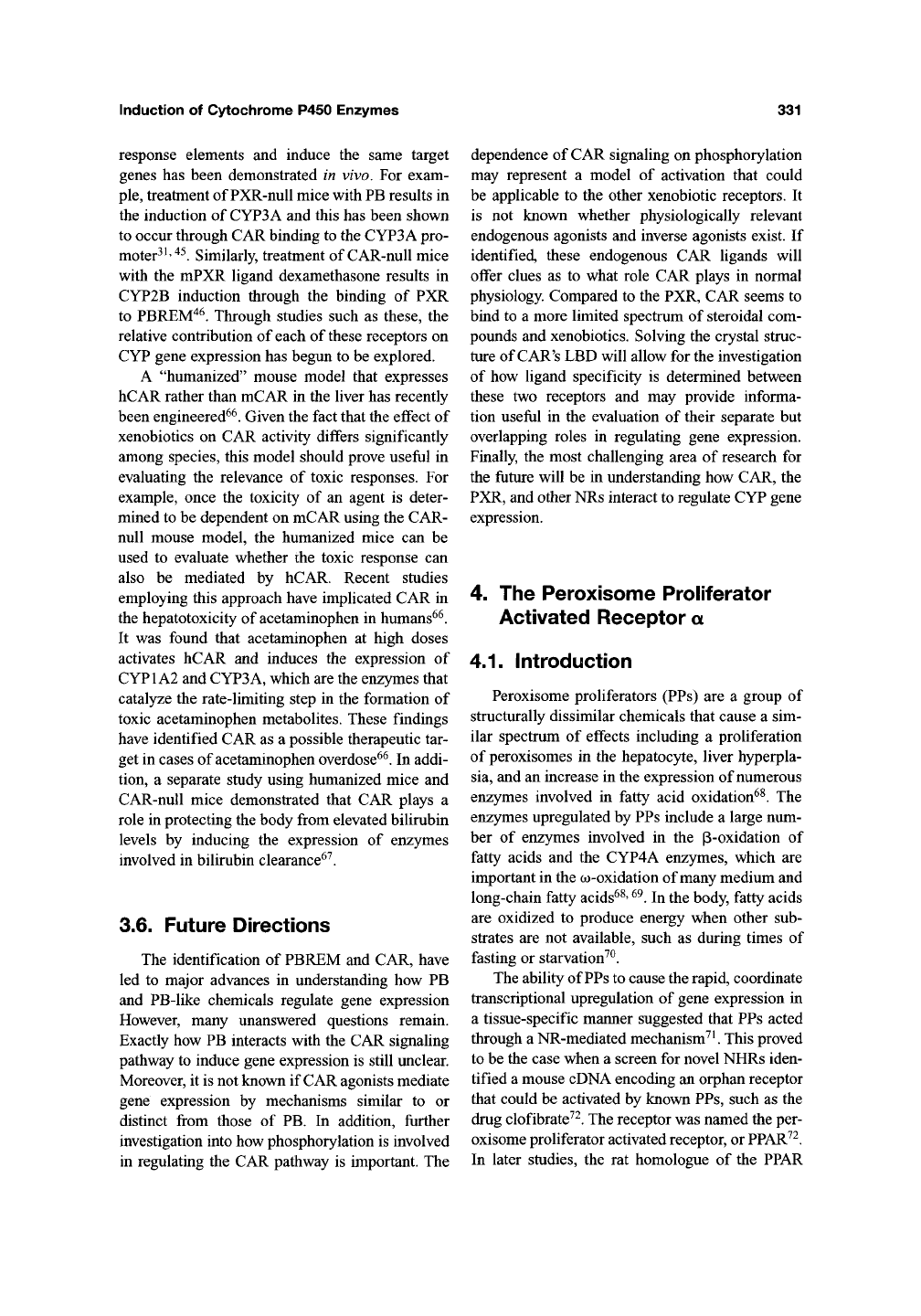
Induction of Cytochrome P450 Enzymes
331
response elements and induce the same target
genes has been demonstrated in vivo. For exam-
ple,
treatment of PXR-null mice with PB results in
the induction of CYP3A and this has been shown
to occur through CAR binding to the CYP3A pro-
moters^''^^. Similarly, treatment of CAR-null mice
with the mPXR ligand dexamethasone results in
CYP2B induction through the binding of PXR
to PBREM"^^. Through studies such as these, the
relative contribution of each of these receptors on
CYP gene expression has begun to be explored.
A "humanized" mouse model that expresses
hCAR rather than mCAR in the liver has recently
been engineered^^. Given the fact that the effect of
xenobiotics on CAR activity differs significantly
among species, this model should prove useful in
evaluating the relevance of toxic responses. For
example, once the toxicity of an agent is deter-
mined to be dependent on mCAR using the CAR-
null mouse model, the humanized mice can be
used to evaluate whether the toxic response can
also be mediated by hCAR. Recent studies
employing this approach have implicated CAR in
the hepatotoxicity of acetaminophen in humans^^.
It was found that acetaminophen at high doses
activates hCAR and induces the expression of
CYP1A2 and CYP3A, which are the enzymes that
catalyze the rate-limiting step in the formation of
toxic acetaminophen metabolites. These findings
have identified CAR as a possible therapeutic tar-
get in cases of acetaminophen overdose^^. In addi-
tion, a separate study using humanized mice and
CAR-null mice demonstrated that CAR plays a
role in protecting the body from elevated bilirubin
levels by inducing the expression of enzymes
involved in bilirubin clearance^^.
3.6. Future Directions
The identification of PBREM and CAR, have
led to major advances in understanding how PB
and PB-like chemicals regulate gene expression
However, many unanswered questions remain.
Exactly how PB interacts with the CAR signaling
pathway to induce gene expression is still unclear.
Moreover, it is not known if CAR agonists mediate
gene expression by mechanisms similar to or
distinct from those of PB. In addition, fiirther
investigation into how phosphorylation is involved
in regulating the CAR pathway is important. The
dependence of CAR signaling on phosphorylation
may represent a model of activation that could
be applicable to the other xenobiotic receptors. It
is not known whether physiologically relevant
endogenous agonists and inverse agonists exist. If
identified, these endogenous CAR ligands will
offer clues as to what role CAR plays in normal
physiology. Compared to the PXR, CAR seems to
bind to a more limited spectrum of steroidal com-
pounds and xenobiotics. Solving the crystal struc-
ture of CAR'S LBD will allow for the investigation
of how ligand specificity is determined between
these two receptors and may provide informa-
tion useful in the evaluation of their separate but
overlapping roles in regulating gene expression.
Finally, the most challenging area of research for
the future will be in understanding how CAR, the
PXR, and other NRs interact to regulate CYP gene
expression.
4. The Peroxisome Proliferator
Activated Receptor a
4.1.
Introduction
Peroxisome proliferators (PPs) are a group of
structurally dissimilar chemicals that cause a sim-
ilar spectrum of effects including a proliferation
of peroxisomes in the hepatocyte, liver hyperpla-
sia, and an increase in the expression of numerous
enzymes involved in fatty acid oxidation^^. The
enzymes upregulated by PPs include a large num-
ber of enzymes involved in the p-oxidation of
fatty acids and the CYP4A enzymes, which are
important in the co-oxidation of many medium and
long-chain fatty
acids^^'
^^.
In the body, fatty acids
are oxidized to produce energy when other sub-
strates are not available, such as during times of
fasting or starvation^^.
The ability of PPs to cause the rapid, coordinate
transcriptional upregulation of gene expression in
a tissue-specific manner suggested that PPs acted
through a NR-mediated mechanism^ ^ This proved
to be the case when a screen for novel NHRs iden-
tified a mouse cDNA encoding an orphan receptor
that could be activated by known PPs, such as the
drug clofibrate^^. The receptor was named the per-
oxisome proliferator activated receptor, or PPAR^^.
In later studies, the rat homologue of the PPAR

332
Susanne N. Williams et a/.
was identified and it was found that the receptor
could not only be activated by PPs, but also by
endogenous fatty acids^^.
4.2.
PPAR Isoforms
The PPAR that was originally cloned from
mouse is now known as the alpha isoform, or
PPARa. This designation arose after the identifi-
cation of two additional distinct PPAR isoforms,
termed PPARp (also referred to as 8) and PPAR7
The three PPAR isoforms are encoded by three
separate genes and have been identified in many
species including human, rat, and rabbit^^. The
three PPAR isoforms play distinct roles and
display tissue specific expression pattems^"^. The
PPARa is highly expressed in the liver and kid-
ney and plays a major role in regulating the catab-
olism of fatty acids. Not surprisingly, the CYP4A
enzymes are coexpressed with PPARa in these
tissues^^. The PPAR7 gene actually gives rise to
two gene products, PPAR7I and PPAR72, through
differential promoter usage. The PPAR72 isoform
is highly expressed in adipose tissue and mediates
adipogenesis and lipid storage; however, PPAR7I,
which is expressed more broadly and at lower lev-
els,
can also induce adipogenesis^^. The PPARp
is ubiquitously expressed and while the exact
physiological function of this isoform is still
unclear, recent findings have suggested that this
isoform modulates the activity of both PPARa
and PPAR7^l Since PPARp and PPAR7 do not
seem to regulate the expression of CYP4A or any
other P450 enzyme, these isoforms will not be
discussed to any great extent.
4.3.
PPARa Ligands
While the quantitative effects of agonist bind-
ing on the activity of PPARa seem to be species-
specific, the spectrum of ligands that can activate
the PPARa across species is similar. Clofibrate,
originally recognized for its ability to increase both
the number and size of peroxisomes when admin-
istered to rats, is considered the prototype for a
class of drugs called fibrates, which are all potent
PPARa ligands^^'
^^.
The fibrate drugs are widely
used today as lipid lowering agents in humans.
Other synthetic ligands of the PPARa include
the industrial plastisizer mono (2-ethylhexyl)
phthalate, trichloroacetic acid, and the pesticide
j)jj8o Interestingly, these xenobiotics induce the
expression of CYP4A even though this enzyme
does not seem to play a role in their metabolism.
Many of the endogenous fatty acids that are
metabolized by CYP4A are also PPARa ligands.
These include an array of saturated and unsatu-
rated very long-chain fatty acids, such as linoleic
acid, palmitic acid, and arachidonic acid^^' ^^
Moreover, findings using acyl-CoA oxidase
(AOX)-null mice suggest that the acyl-CoA deriv-
atives of very long-chain fatty acids are most
likely endogenous PPARa ligands. In mice with a
disrupted AOX gene, acyl-CoA derivatives accu-
mulate to high levels and the animals display a
phenotype similar to that seen after treatment of
rodents with synthetic PPs^^. Some eicosanoids
and eicosanoid metabolites that are important
mediators of inflammation, including leukotriene
B4 and prostaglandins, are PPARa ligands^^' ^^.
These arachidonic acid derivatives can be metab-
olized by CYP4A to compounds that are inactive
in terms of mediating the inflammatory
response^^. In light of the role that PPARa plays in
the induction of CYP4A, it is not surprising that
mice lacking PPARa have been demonstrated to
display a prolonged inflammatory response^^.
4.4. Activation of Transcription
The experimental drug Wy
14643,
an acetic
acid derivative of clofibrate, is a potent PPARa
agonist and was instrumental in elucidating the
signaling pathway of PPARa. The PPARa binds
as a heterodimer with RXR to DNA motifs
termed peroxisome proliferator response elements
(PPREs) (Figure 8.4)^^ The core PPRE sequence
was initially identified as an imperfect DRl motif
by analyzing the promoter of the AOX gene^^.
Unlike the PXR and CAR, PPARa can form het-
erodimers with either ligand-free or 9-cis retinoic
acid-bound RXR, and ligand binding to either
RXR or PPARa can activate gene expression
through PPREs^^'
^^.
Other NRs can also bind to
PPREs and competition for binding has been
observed among the three PPAR isoforms as
well as
HNF-1,
thyroid receptor, and RXR/RXR
dimers. Depending on the NR complex bound to
the PPRE, the transcription of a target gene can be
either activated or repressed. Studies have shown
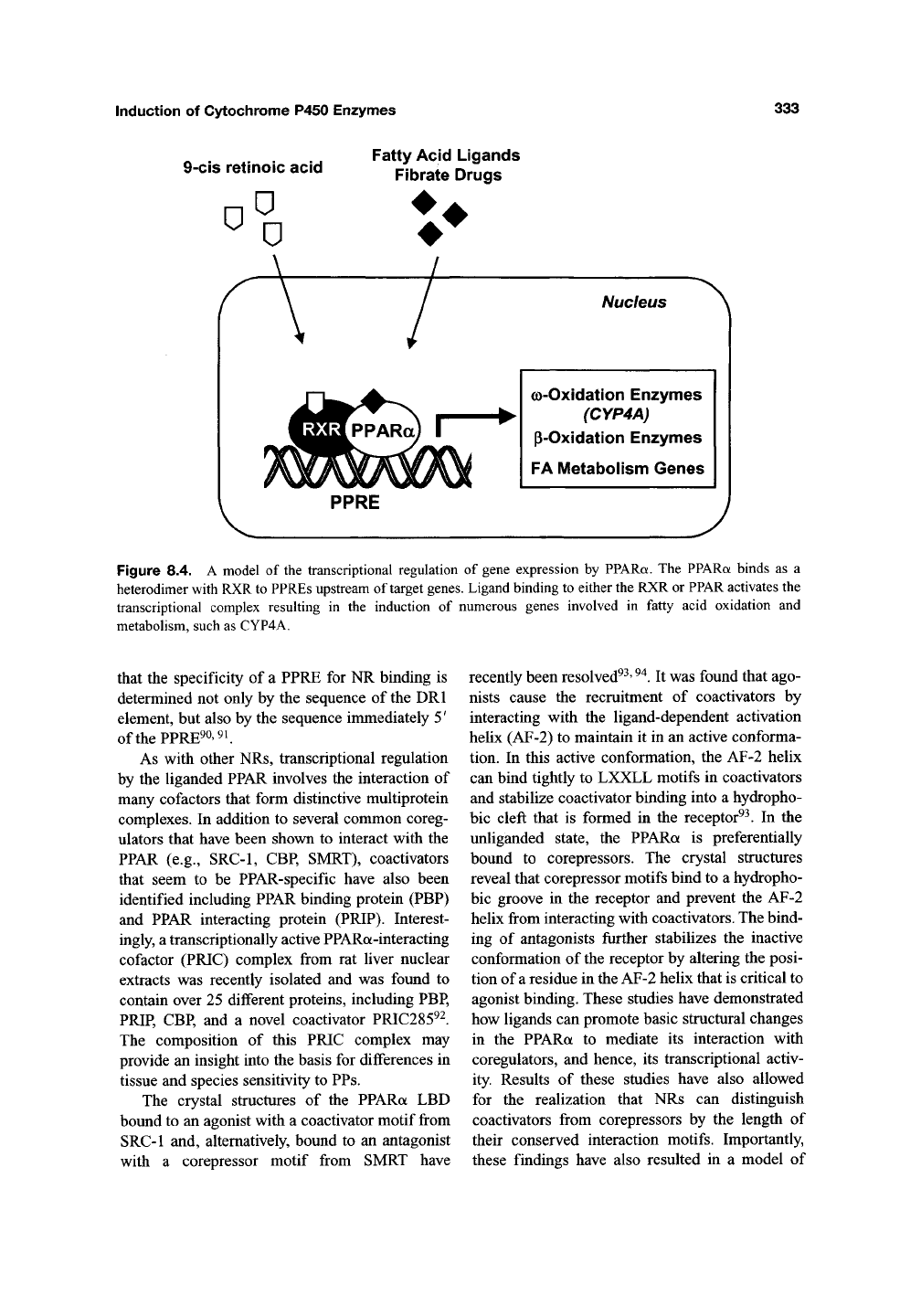
Induction of Cytochrome P450 Enzymes
333
9-cis retinoic acid
a
a
a
Fatty Acid Ligands
Fibrate Drugs
V
Nucleus
G)-Oxidation Enzymes
(CYP4A)
P-Oxidation Enzymes
FA IVIetabolism Genes
PPRE
Figure 8.4. A model of the transcriptional regulation of gene expression by PPARa. The PPARa binds as a
heterodimer with RXR to PPREs upstream of target genes. Ligand binding to either the RXR or PPAR activates the
transcriptional complex resulting in the induction of numerous genes involved in fatty acid oxidation and
metabolism, such as CYP4A.
that the specificity of a PPRE for NR binding is
determined not only by the sequence of the DRl
element, but also by the sequence immediately 5'
ofthePPRE^O'^i.
As with other NRs, transcriptional regulation
by the liganded PPAR involves the interaction of
many cofactors that form distinctive multiprotein
complexes. In addition to several common coreg-
ulators that have been shown to interact with the
PPAR (e.g.,
SRC-1,
CBP, SMRT), coactivators
that seem to be PPAR-specific have also been
identified including PPAR binding protein (PBP)
and PPAR interacting protein (PRJP). Interest-
ingly, a transcriptionally active PPARa-interacting
cofactor (PRIC) complex from rat liver nuclear
extracts was recently isolated and was found to
contain over 25 different proteins, including PBP,
PRIP,
CBP, and a novel coactivator PRJCISS^^.
The composition of this PRIC complex may
provide an insight into the basis for differences in
tissue and species sensitivity to PPs.
The crystal structures of the PPARa LBD
bound to an agonist with a coactivator motif from
SRC-1 and, alternatively, bound to an antagonist
with a corepressor motif from SMRT have
recently been resolved^^'
^'^.
It was found that ago-
nists cause the recruitment of coactivators by
interacting with the ligand-dependent activation
helix (AF-2) to maintain it in an active conforma-
tion. In this active conformation, the AF-2 helix
can bind tightly to LXXLL motifs in coactivators
and stabilize coactivator binding into a hydropho-
bic cleft that is formed in the receptor^^. In the
unliganded state, the PPARa is preferentially
bound to corepressors. The crystal structures
reveal that corepressor motifs bind to a hydropho-
bic groove in the receptor and prevent the AF-2
helix from interacting with coactivators. The bind-
ing of antagonists fiirther stabilizes the inactive
conformation of the receptor by altering the posi-
tion of a residue in the AF-2 helix that is critical to
agonist binding. These studies have demonstrated
how ligands can promote basic structural changes
in the PPARa to mediate its interaction with
coregulators, and hence, its transcriptional activ-
ity. Results of these studies have also allowed
for the realization that NRs can distinguish
coactivators from corepressors by the length of
their conserved interaction motifs. Importantly,
these findings have also resulted in a model of
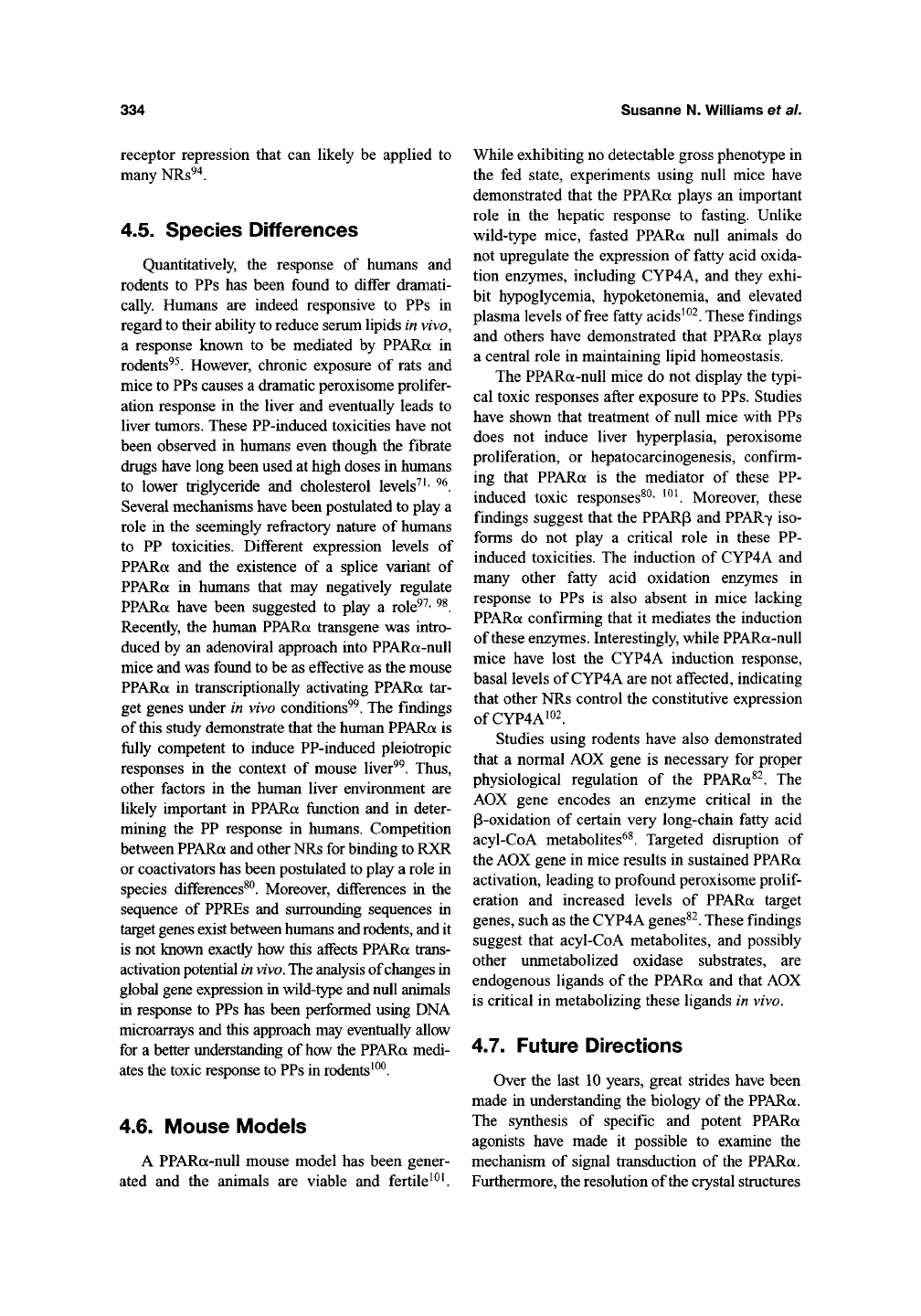
334 Susanne N. Williams ef al.
receptor repression that can likely be applied to
many NRs^'^.
4.5. Species Differences
Quantitatively, the response of humans and
rodents to PPs has been found to differ dramati-
cally. Humans are indeed responsive to PPs in
regard to their ability to reduce serum lipids in vivo,
a response known to be mediated by PPARa in
rodents^^. However, chronic exposure of rats and
mice to PPs causes a dramatic peroxisome prolifer-
ation response in the liver and eventually leads to
liver tumors. These PP-induced toxicities have not
been observed in humans even though the fibrate
drugs have long been used at high doses in humans
to lower triglyceride and cholesterol levels^^' ^^.
Several mechanisms have been postulated to play a
role in the seemingly refractory nature of humans
to PP toxicities. Different expression levels of
PPARa and the existence of a splice variant of
PPARa in humans that may negatively regulate
PPARa have been suggested to play a role^^' ^^.
Recently, the human PPARa transgene was intro-
duced by an adenoviral approach into PPARa-nuU
mice and was found to be as effective as the mouse
PPARa in transcriptionally activating PPARa tar-
get genes under in vivo conditions'^. The findings
of this study demonstrate that the human PPARa is
fully competent to induce PP-induced pleiotropic
responses in the context of mouse liver''. Thus,
other factors in the human liver environment are
likely important in PPARa function and in deter-
mining the PP response in humans. Competition
between PPARa and other NRs for binding to RXR
or coactivators has been postulated to play a role in
species differences^^. Moreover, differences in the
sequence of PPREs and surrounding sequences in
target genes exist between humans and
rodents,
and it
is not known exactly how this affects PPARa trans-
activation potential
in
vivo.
The analysis of changes in
global gene expression in wild-type and null animals
in response to PPs has been performed using DNA
microarrays and this approach may eventually allow
for a better understanding of
how
the PPARa medi-
ates the toxic response to PPs in rodents^^^.
4.6.
Mouse Models
A PPARa-null mouse model has been gener-
ated and the animals are viable and fertile^^^.
While exhibiting no detectable gross phenotype in
the fed state, experiments using null mice have
demonstrated that the PPARa plays an important
role in the hepatic response to fasting. Unlike
wild-type mice, fasted PPARa null animals do
not upregulate the expression of fatty acid oxida-
tion enzymes, including CYP4A, and they exhi-
bit hypoglycemia, hypoketonemia, and elevated
plasma levels of free fatty
acids^^^.
These findings
and others have demonstrated that PPARa plays
a central role in maintaining lipid homeostasis.
The PPARa-null mice do not display the typi-
cal toxic responses after exposure to PPs. Studies
have shown that treatment of null mice with PPs
does not induce liver hyperplasia, peroxisome
proliferation, or hepatocarcinogenesis, confirm-
ing that PPARa is the mediator of these PP-
induced toxic responses^^' ^^^ Moreover, these
findings suggest that the PPARp and PPAR7 iso-
forms do not play a critical role in these PP-
induced toxicities. The induction of CYP4A and
many other fatty acid oxidation enzymes in
response to PPs is also absent in mice lacking
PPARa confirming that it mediates the induction
of these enzymes. Interestingly, while PPARa-null
mice have lost the CYP4A induction response,
basal levels of CYP4A are not affected, indicating
that other NRs control the constitutive expression
ofCYP4Aio2.
Studies using rodents have also demonstrated
that a normal AOX gene is necessary for proper
physiological regulation of the PPARa^^. The
AOX gene encodes an enzyme critical in the
P-oxidation of certain very long-chain fatty acid
acyl-CoA metabolites^^. Targeted disruption of
the AOX gene in mice results in sustained PPARa
activation, leading to profound peroxisome
prolif-
eration and increased levels of PPARa target
genes,
such as the CYP4A
genes^^.
These findings
suggest that acyl-CoA metabolites, and possibly
other unmetabolized oxidase substrates, are
endogenous ligands of the PPARa and that AOX
is critical in metabolizing these ligands in vivo.
4.7.
Future Directions
Over the last 10 years, great strides have been
made in understanding the biology of the PPARa.
The synthesis of specific and potent PPARa
agonists have made it possible to examine the
mechanism of signal transduction of the PPARa.
Furthermore, the resolution of the crystal structures
